
- Home
- Introduction
- History Speaks
- Transportation
- Public Services
- Commerce
- Sports
- Miscellaneous Stuff

|
Industry Stark's Mill The early settlers who in most cases had no way of transporting their wheat to the mill, for grinding into flour, carried it long distances in sacks on their backs. These people seldom left crusts uneaten. Mr. Valentine provided a market for logs and wheat to the early pioneers until 1872 when the business was bought by Mr. James Stark who had formerly owned and operated a flour mill at Dunblane. In 1884 the flour mill burnt down but was replaced the next year by the present mill. The by-products, that is, bran, shorts, and low grade flour were sold to the local farmers for feed. The flour was sold locally and exported to England, Scotland, Gibraltar and the middle east, under the trade names of Excelsior, Prairie Rose, and Pure Cream.
The mill continues to serve as a feed mill and feed store using the original water power to grind feed grains used by the farmers in the area.
|
"Fisher's" Mills
In 1857 a man named Lyons (David Lyon 1819-1906) bought the mill property from S.T. Rowe, made a start at building a dam, and put up the frame of a sawmill. High water made havoc with the dam before it was completed and the project was abandoned. In 1858 David Hanna, his father and a brother took over the mill property. They built a dam, cut out the mill race and erected a grist mill on the foundation of Lyon’s sawmill. They also erected a sawmill on the south side of the river and equipped it with machinery. In 1869 D. Fisher bought the Hanna Mills and operated a flour mill and a sawmill. Later he built a new dam where the present one is located. (the former dam was farther west on the Teeswater). Carlaw and Lindsey got possession of the mills in December 1921. Just previous to this, the mill was operated by Richard Skinner for the owner Elwood Armbruster of Niagara Falls. After Harold Lindsey bought Walter Stark’s flour and feed store in 1922, Mr. Carlaw continued to operate the mill. A fire in the spring of 1923 burned the top part of the mill, but the ground floor was saved. The mill was repaired, and with further changes made by Rudy Boettger, appears as it is to-day. In 1929 the dam was badly damaged by flood water. Up to 1936 the dam was made of wood and suffered damage at almost every spring freshet. The dam, incorporating much cement, was rebuilt by Rudy Boettger with the assistance of Angus, Murdock, and Gus. McArthur, Bruce McTeer and Gillies Parker. A companion industry, the grinding of alfalfa into meal was carried on in part of the mill. For a time the Winch Brothers assisted in this enterprise which shipped alfalfa meal to Glasgow, Scotland. The part of the mill in which alfalfa meal Was produced, has since been torn down and been replaced by a storehouse at the west side of the mill. About 1934 the mill, still owned by Mr Armbruster, was operated by Irwin McLaughlin. In 1956 Rudy Boettger bought the mills, installed modern mixers, made other changes already mentioned, and carried on a successful business until he sold it in 1973 to Robert James of Walkerton.
|
The Paisley Agricultural Works
Submitted by Miss M. E. Boyle Of the early industries in Paisley, I am especially interested in the history of the one foundry known as the Paisley Agricultural Works. It was located on the land now known as Willow Creek Park. The tall chimney is all that remains now, but the foundry covered the entire area of the park and owned three lots across the Willow Creek. It was a huge building of two storeys. A molding shop was situated at the south-west corner of the building near the creek. The centre part of the building was filled with all kinds of machinery for running the business. The north part was the work shop, and beyond it a “show” room for the finished products. The upper storey was used for storage and for living quarters of some of the sixty employees. Who the founder was, I do not know, but I do know that it was an old institution. Among the first owners were Bradley and Cascaden. In the early days it became the property of James Laidlaw of Milton, a brother of the owner of the Laidlaw Lumber Company of Toronto. Later, Mr. Laidlaw moved to Manitoba and my grandfather John Stewart, “the Rebel” sold his beautiful home and farm near Milton and with his family moved to Paisley in the sixties, to assume the ownership of the foundry. My father, E.F. Boyle came to Paisley from Toronto to be Superintendent of the foundry. In the 80’s he took over the business from John Stewart, now his father-in-law. John Story of Milton was a partner. When reapers were a novelty in the country, they manufactured the “Paisley Wrought Iron Harvester” which was considered then the best machine north of Toronto. In my granclfather’s and in my father’s early days as many as 60 men were employed. Old “Tom the Molder” had the job of looking after the casting or pouring of molten iron into the sand boxes where wooden patterns were buried. Many articles in addition to farm machinery were manufactured - iron pots, spiders (frying pans), hitching posts, iron fences, and ornate garden chairs, tables, etc. In the line of farm machinery which seems to be its specialty, the foundry manufactured straw cutters, turnip cutters, the celebrated “Harvest Queen” reaper, the unrivalled “Sellar Plow”, gang plows, horse rakes, combined scufflers for scuffling and hilling potatoes, single and double turnip seeders. Their “Number 7” plow could be had on trial, and a written guarantee was given with all machines and implements sold from the “Works”. All kinds of repairing and jobbing were done. Engine repairing was a specialty and all kinds of mill work was done on short notice and at most reasonable rates. In the early days travelling agents were on the road “whipping” up trade. But the pace of change proved too rapid. Huge industries like Massey-Harris soon spelt death to the smaller companies, and by the early 1900’s business was slipping and fewer workmen were required. One of the last associates of my father in the business was John Elwes, father of the long-time town clerk, Don. Elwes. I recall one incident in which Mr. Elwes was badly burned by the upsetting of a pot of molten iron on his leg during casting. The business was closed, but the building remained until 1923 at which time the building was dismantled and the lumber and timbers were sold. In 1928, after my father’s death, the property was sold to the village and Willow Creek Park was created. |
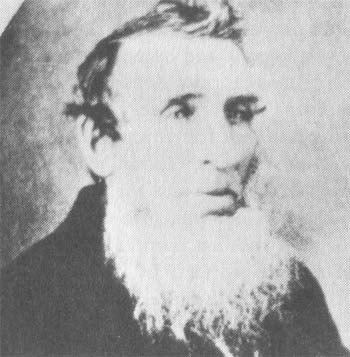 John S. Stewart 1808-1893 |
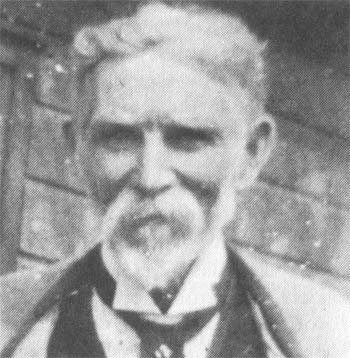 Edward Francis Boyle 1850-1928 |
J. B. McArthur's Carriage Works
J.B. McArthur was born at Ardtalnaig, Perthshire, Scotland in 1832. He learned the blacksmithing with his father and at 22 years of age came to Canada. After a few years spent at Kenmore, Dunbarton and Fergus he came to Paisley in 1867 where he planned to engage in his trade. Going to Montreal, he purchased so extensive a stock of iron that men who saw it unloaded from the boat at Southampton expressed their curiosity as to who was such a fool as to bring the shipment to the new and unheard of industry said to be in Paisley. Mr. McArthur’s optimistic view of the future was not a mistaken one. Almost at once he experienced a trade boom, and his stock of iron was used up within the year. The late Peter Reid of Elderslie was the first man at the anvil in the new shop. John Deans was the painter. John and Thomas Wright were the first wagon makers employed. They worked long hours filling the demand for plows, harrows and other equipment for tilling the virgin soils of the surrounding area. In the making of plows Mr. McArthur made a phenomenal success with a form of mouldboard which he designed, patented and manufactured, and with which, under 1920 conditions and methods of specialization, might bring a fortune in itself. This mouldboard eventually brought the patentee the sobriquet of “Prize Winning McArthur”, as his plows invariably won the prizes in all the plowing competitions in the land. Old country makers adopted it and when the late A. Ross of Underwood sent to Scotland for the best mouldboard that could be obtained, he was furnished with one of McArthur’s patent. Fleury Co., Ontario makers, sent for Mr. McArthur to build a plow with a mouldboard such as was on an old one of his make. Mr. McArthur in the course of a few years, turned his attention more to carriage building, his shops becoming likewise famous for the handsome and durable carriages, buggies, democrats, and other wheeled rigs, which captured all the prize tickets wherever exhibited at the local and county fairs. Mr. McArthur died December 29, 1920. |
Paisley Maufacturing Company
|
From the july 23, 1959 issue of the Paisley Advocate. One of this village’s most enterprising firms since its establishment here in 1945, Paisley Manufacturing Co. will close its plant here and move to Owen Sound, where it will operate in new quarters in conjunction with two other allied companies, the Canadian Library Supplies Ltd., and the J. Drinkwater Book Binding Co. The plant here, employs five or six men, but it is expected the staff will increase to about fifteen as the company’s trade expands. Mr. Watson expects the transfer of the plant will be made in September. |
|
James A. McKinnon - Contractor
Workmen with J. A. McKinnon |
Paisley Brick & Tile
Submitted by Mrs. John Seiler. Bell Bros., that is Hiram and William Bell, purchased the plant on March 1, 1892, but it was operated by Robert & Joshua Bell. At that time the brick press was run by horsepower, and now that there was horsepower, it was possible to make tile too. In May 30, 1901, Robert Bell and Joshua Bell bought the plant. There were no large tile made then, only sizes 2%”, 3”, 3%”, and 4”. Horsepower was replaced by steam power to run machinery, and after that about 1,000,000 brick were manufactured, and about 1,000,000 tile, per year. A new brick machine was put into operation which extruded the clay in long streams; then it was cut off the proper length by wires. These were called wire cut brick. Up until 1902 brick were burned by stacking dried brick in long rectangular piles, with a tunnel left open through the middle. This tunnel was filled with huge blocks of wood. Then the wood was lit at each end. As it burned, more wood was added and the fire burned right through the tunnel, until the brick were burned. This was called an open square kiln. About this time a new type of kiln came into use. It was shaped like a beehive, with several fireboxes built into its walls, and it was permanent. This type of kiln was filled with tile or brick, then sealed up at the doors with brick plastered over with a mixture of mud, sand, and water. Then the fire boxes were lit, and with the draft system built under the floor, the heat was drawn into the kiln to burn the tile or brick. The kiln fires were kept going until it was judged the burn was done. These kilns would burn about 10,000 -3” tile or 30,000 brick at a time. Around 1908, two more round kilns were built, and tile sizes increased, so tile were now available from 3” up to 8”. Horse drawn carts filled by men with shovels, were used to get clay from the pit. Many of the buildings in and around Paisley were built with brick made in this fashion. Some examples are the Frank Ballachey home, the Sam Ballachey home, the Alex. Galbraith house, and the H.B. Putnam house. Also the Paisley school built in 1914. On June 4, 1918, Joshua Bell sold his share in the brick and tile yard to Robert Bell, and the yard was then registered under Robert Bell & Son, the son being Reginald Bell. A large open air drying shed was built for drying tile. On Oct. 5, 1919, Robert Bell & Son sold the yard to Winch Bros. This was Stuart Winch and Leslie Winch. The brick output in 1919 was 250,000 and in tile 200,000. In 1921, these figures increased to brick: 350,000, tile: 250,000. In 1926 the plant machines were converted to Hydro Power, while in the pit horses and scrapers were used to get clay. On March 7, 1927, Leslie Winch sold his share of the brick and tile yard to Stuart Winch and it became known as Paisley Brick & Tile Yard. About 1929, brick output decreased to about two kilns a year, as building material of this +type was not in great demand in this area, but tile drainage began to be very important to farming operations, and about 400,000 tile were manufactured a year. Production stayed on about this scale until 1940, when the demand slowed down just before the Second World War. About 1933, a steam shovel was purchased and put into operation for digging clay from the pit. Now horsepower was a thing of the past in the yard. The Paisley Brick &Tile Yard closed down in 1942 and remained closed until 1946 at the end of the war, when it was reopened. The steam shovel in the pit was at this time converted to run with a gasoline motor, which continued to operate until the end of 1951. Stuart A. Winch sold Paisley Brick & Tile Yard to John M. Seiler on Dec. 15, 1948. The plant carried on in about the same manner until about 1952, at which time the kilns were converted from cord wood to coal burning. Two 40’ chimneys were built, and new type floors were put in the kilns for evener burning. Heat gauges were installed to give exact temperatures in the kilns, hence eliminating much guesswork. Coal, in place of wood, decreased the burning time from 6 days to 3 days per burn. This speeded up production from 400,000 to 600,000 tile per year. In 1953 a new drying kiln was built. This was to thoroughly dry the tile in a shorter time. Previously tile were dried in an open air drying shed. Sometimes it took as long as a month, or as little as a week, to dry in this way, depending on the weather. Now they could be dried in 3 days regardless of the weather. This drying kiln held 15,000 tile. It was designed to dry tile by drawing the heat off a kiln that had finished burning, by means of a large fan and air ducts. This helped to cool a kiln of burned tile quicker as well as to insure that there were dry tile ready for another burn, making use of what had otherwise been wasted heat. A new tile making machine and a semi-automatic tile cutter, with larger capacity to replace hand cutter, were installed. The plant machinery was changed over from Hydro to Diesel Power with a 100 hp. diesel engine. Wheelbarrows, which had been the only way of moving tile around until now, were discarded, and racks were built on which to place tile on end. This method produced more perfectly round tile, as they had no chance to flatten out while soft and lying on their sides. A new lift truck was purchased to transport these racks of tile, and new cement floors were poured throughout the plant to run the lift truck on.Also the gas shovel was discarded for digging the clay in the pit, and replaced by a bulldozer. In 1954, a building was erected over the kilns, and a second drying kiln was added. This drying kiln would hold 25,000 tile. More drying racks were built as well. This increased production to 800,000 tile per year. These dryers extended the working season from 6 months to 8 months. Brick, which had been produced at the rate of 100,000 per year, were discontinued completely, and brick drying hacks were torn down. A large open air drying shed, no longer needed to dry tile, was restored to house empty racks, also extra dry tile on racks until needed. In Dec. of 1954 the plant burned. Most of the machinery was found, after overhauling, to be usable, but the buildings had to be replaced. The balance of the winter was spent in erecting concrete block buildings to house the plant. A new fully-automatic cutter was purchased, and a second lift truck was installed.Also large rollers, called disintegrators, were installed to pulverize dry clay, so water could be added after, giving a smoother material to work with, and eliminating the clay tempering in the pit. An open air clay storage shed was built to make it possible to manufacture in wet weather. Previously if there was too much wet weather, clay became too wet to use, necessitating a partial shutdown until it dried out. Live conveyor belts were installed to replace wheelbarrows in emptying the kilns. These improvements increased production to about 750,000 tile per year.Also a new reservoir was built with pumping system, hydrant, and fire hoses. On the 8th of July, 1956, the plant was hit by a tornado and was partially destroyed, but was rebuilt again that summer without too much production loss.A limited company was formed at that time, named Paisley Brick & Tile Co. Limited, as it is now. Not many more changes were made until 1961 when coal was replaced by oil burners for burning the kilns, cutting down labor, and simplifying burning problems. The following year a new 30’ modern kiln was built, cutting down fuel costs and increasing production to 1,000,000 tile per year. A second bulldozer was purchased for digging clay. In 1965 delivery Palletizing was installed. These pallets are large bins, holding 810-4” tile, which are transported around the plant and onto trucks by fork lift truck. Unit lifts were installed on delivery trucks to unload pallets of tile at the delivery point. This cut handling costs and speeded up delivery to the customer. The Paisley Brick & Tile Co. Limited was reconverted to Hydro Electric Power in 1966. In 1967 a new concrete enclosed heated clay storage building was erected. This will increase each working season to 9 or 10 months, and production to 1,500,000 tile per year while employing only about 10 men. In 1949 about 18 men were required to manufacture 600,000 tile per year, but with the new changes it was possible to cut down labor, make the work easier, and increase production to that extent. |
Paisley Creamery
| |||
The Paisley Creamery building as it is known today was originally owned and operated about 1886 by the Coleman Meat packing Industry until about 1900 When the business moved to Kincardine. At this time the Paisley Creamery which had been built by Sam Ballachey, was owned and operated by Mr. ]ohn Logie and his partner Mr. Irwin, and their operation was located on Mill Street where the present Cider Mill is now located. This site became a cider mill in 1924. The brick building on Queen Street North remained vacant until about 1919, when Messrs. Logie and Irwin moved their operation there. Peter Cutter purchased the creamery about 1947 and operated it until April 1958 when it was bought out by U.D.P.C. at Tara, and was used as a receiving station for the Tara operation, and egg-grading station until 1968. It has been vacant since, but it is rumored that a metal fabricating industry from Hamilton is moving in. |
 |
||
|
|||
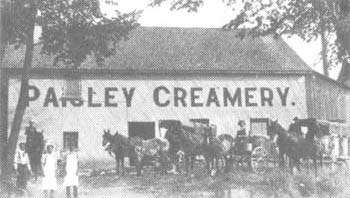 Paisley Creamery on Mill Street |
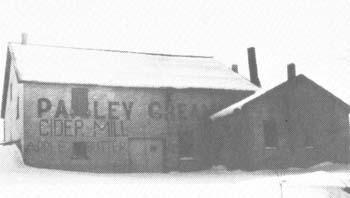 Paisley Cyder Mill formerly the Creamery |
||
Carlaw's Woodenware This industry was begun in 1932 by Oliver Carlaw who owned the grist mill on Mill Street. Part of the work was done in the mill, and the remaining work was completed in a building at the rear of his residence, Queen Street south. In 1934, Mr. Carlaw purchased the former Methodist Church. A partnership of Mr. Carlaw and his son Howard was formed in 1943, and in 1947 a limited company known as Carlaw’s Woodenware manufactured berry boxes, plant boxes, plant cubes, and egg crates. The plant was capable of performing all the necessary operations from the peeling of the light veneer from the logs to the finished product. The plant narrowly escaped destruction by fire in January, 1949. From 1957 to 1968 newly-added machinery and a large drying kiln made possible the employment of about twenty people, and at times it was necessary to operate a night shift. Mr. Carlaw, founder of the business, passed away in December 1967. His son carried on the business until December 1968, when ill health forced the closing of the industry. The building and contents were totally destroyed by fire April 11, 1970 with an estimated loss of $25,000. |
N. E. Hagedorn & Sons Ltd.
In 1930 this small business took on Farm Drainage, and in the next eighteen years over two million feet of tile drains were installed in the counties of Bruce, Grey and Huron. In the meantime, the seed-cleaning business continued to grow and in 1932 the seed-cleaning plant was moved to a small shop on the site of the present Dairy Bar. In 1934 the business was moved from here to the upper floor of what was then Jack Smart’s blacksmith shop. This old building has been torn down to make way for a parking lot on the north side of the arena. In 1939 a new building was erected on Church Street. This building housed an extensive modern seed-cleaning plant as well as a workshop in which was manufactured farm Wagons and sleighs during the slack winter months. In 1942 an addition to the building made for a larger workshop and more extensive seed-cleaning equipment. In 1954 an adjoining building was erected and more machinery added to take care of the increasing demand for seed and grain cleaning. In the season of 1955 the business handled approximately 800,000 pounds of Timothy seed and 250,000 pounds of clover seed as well as an undetermined amount of cereal grains. Further additions to the buildings were made in 1955, 1959 and 1965, to give extra storage space for the ever-increasing volume of seed and fertilizer handled by the business. In 1961, Norman Hagedorn merged his business with an implement dealership owned by his son Harvey. This made a full line of farm equipment available to the farmers of the area. This merger was known as N .E. Hagedorn and Sons, Limited.
Late in 1968 a new concrete block building was erected for general repairing and manufacturing, followed by a new seed-cleaning plant in 1969, and in 1970 by a warehouse. To-day, in its 46th year, the business is thriving under the guidance of the founder and the youthful energies of sons Robert and David. Over the years, all members of the family, either sons or daughters, have had the opportunity of working in the business, and members of the third generation will have the same opportunity. The Company manufactures: snow blowers, front-end loading buckets, post-hole augers, fertilizer spreaders, wagons racks, cattle-dehorning crates, feed carts, bale stookers, bale loaders, scrapers, carriers, self-feeding equipment, trailers, etc. Our Motto is "You name it .... We build it." |
The Broiler Industry
Paisley Broiler Plant |
This industry was begun in 1957 when Rudy Boettger purchased the site at the south-western limits of the village, from Mac Clark. Gillies and James Parker erected the building which was ready for operation in 1958. |
Bruce Packers Ltd. The history of Bruce Packers really began in 1939 when Mr. Theodore Bender came to Paisley from Hanover and purchased the Butcher Shop of Mac Clark. In conjunction with the store he did some custom slaughtering in a small slaughter house located on the Cormack farm on the Elora Road south of Paisley In 1942 he closed his original shop and bought the Orval Burns Grocery and Butcher business. In 1945 he purchased the MacLean Farm, north of the village, where the plant is now located. The original slaughter house was In 1949 the store was sold and Mr. Bender went into the truck and bulldozing business. In 1952 he returned to the meat business and Bruce Packers was born. By 1956 it was well on its way and the Bruce Brand Meats was established. The old building was demolished and a new structure was erected. Since then seven new additions have been added to form the present plant. In 1966 Bruce Packers came under Federal Inspection, which meant that Bruce Packers could also export meat if necessary and provide a much greater service to the community. A Veterinarian (at present Dr. R. Spracklin) from the Canada Department of Agriculture was appointed to inspect all phases of the operation affixing the Canada approval seal to all meats that pass strict regulations. Now this former one-man operation has grown into a major Canadian Industry employing thirty people. In 1972 Bruce Packers was purchased by Mr. Bender’s son Larry Bender. Today Bruce Packers puts a wide range of Bruce County Beef and Pork products on the tables of thousands of homes as well as serving many hotels, hospitals, restaurants and grocery businesses throughout Western Ontario.
|
The Blacksmith Shop
Wilfred Dudgeon in the former J. Smart Blacksmith Shop on Queen Street North. Wilfred now operates from his shop behind his residence on Ross St. |
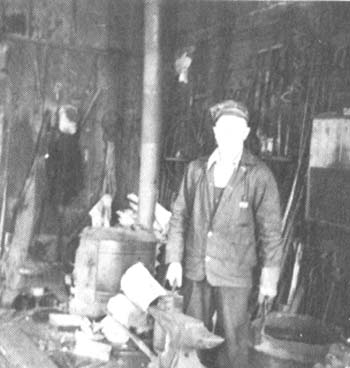 |
Demolition of the Paisley Blacksmith Shop |
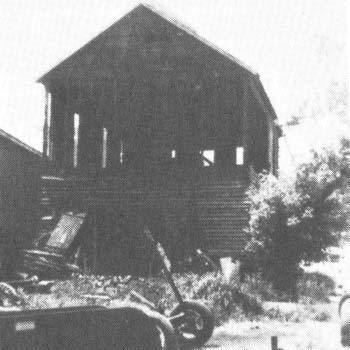 |
| Return to top of Page | Return to top of Page |